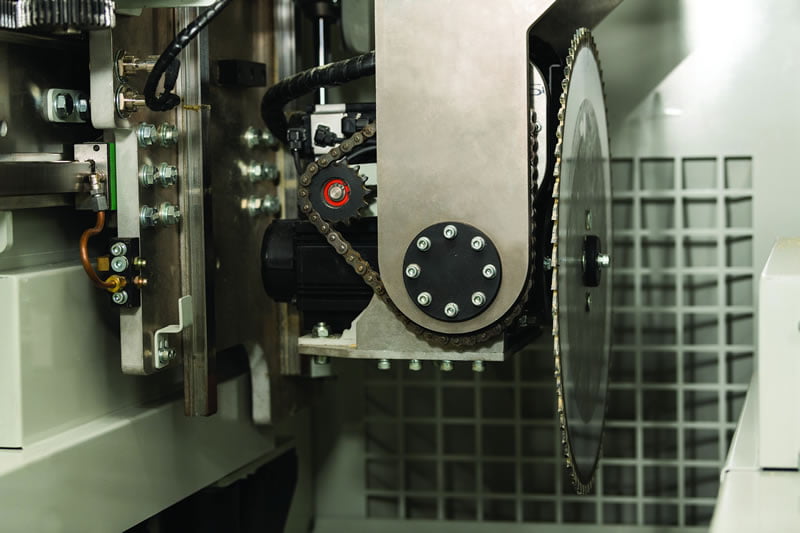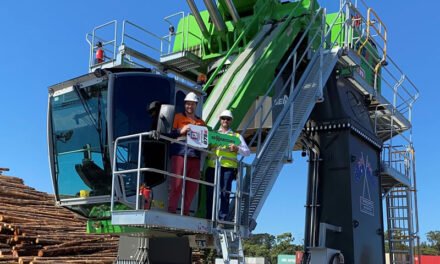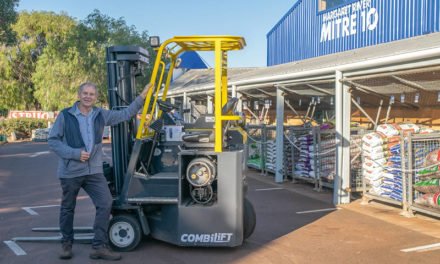When Multinail sat down to design the PieceMaker, their new linear saw, company history, expertise and a long wishlist were all parts of the planning.
Generational change is a necessary part of business success. It can be daunting, especially when an older product has been justly popular for a long time. But it can also be exciting, as the team at Multinail found when they came together to create the PieceMaker linear saw.
“We’ve been building linear saws now for about 15 years,” says Peter Whiteley, operations manager machinery division at Multinail. “We saw a niche in the linear saw market for one that combined up-to-date automation with a small footprint and ease of use. We had a look at the requirements of businesses and identified the exact machine we needed to design to suit the market, and that niche.”
While there were definitely more steps in the design process than that, it’s clearly worked: Multinail has sold 16 PieceMakers in 2019 and the buyers have ranged across the spectrum from small to large truss plants.
With a cost-effective price starting around $300,000, reliable automation, a user-friendly interface and big production gains without additional staff requirements, it’s easy to see why it’s selling well, but that success started with the design team.
A learning process
The company’s previous linear saw model, the MAC Saw, had a decade-long run with several updates along the way. However, while the cutting technology on that saw was still excellent, automation had come a long way in the years since it was developed.
So when Whiteley sat down with his team, they had a simple brief: to come up with the next saw the market needed. And they had a lot of information to start with.
“As with any new development, we looked at what we’d built before and identified where we could improve on it,” Whiteley says. “Then we went to the drawing board with virtually a clean slate and open mind, but thanks to Multinail’s ongoing support and service roles, we were able to take advantage of the market feedback our business development managers and technical support staff were bringing us from the field.”
Several market requests dominated: higher productivity, a small footprint and ease of use combined with being able to do the job as efficiently as possible.
Both the hardware and software were designed with these at front of mind. Omitting the gripper allowed the speed of the saw to increase, and then state-of-the-art automation added to the efficiencies that could be achieved.
“The cutting blade is next generation and there are complex differences to the older saw in the way the PieceMaker operates,” says Whiteley. “These include geometrical differences in the way the saw acts: the axis is completely different on this saw, which allowed us to make a much smaller cabinet that has benefits with all angle cuts.”
Brett Kinny, machinery software and controls manager was also involved in the PieceMaker’s development. “We know that different customers have different priorities,” Kinny says. “We learned that from our MAC Saw experience. Some want to prioritise the least amount of waste, others want the easiest stacking order at the output.
“These are competing ideas, you can’t necessarily do both, but we realised that we could make the PieceMaker have a range of options for optimising, so you can adjust it to optimise over one truss, or multiple trusses or the whole job. You can combine jobs, cut parts of jobs. You can have a set of optimised settings per saw number that allows the detailers to break the jobs up into different parts if, for example, they want to have the chords optimised in a certain way and the webs optimised in a different way.”
This customisation, which is all user-configurable at the saw, also allows for quick responses to changing conditions. As Kinny explains: “If you’re expecting a stock delivery and it doesn’t arrive, you can go into the software and turn off or on certain bits of stock. So if you run out of one length, the machine will immediately change to optimise using the other stock you have in hand.”
Phone friendly
Despite the huge scope of customisation possibilities, the user interface is refreshingly simple. As Whiteley says, “We’ve actually designed it around a mobile phone. If your staff member can use a mobile phone, they can certainly use this machine.”
And while it’s not arduous to learn, the automation brings a new skill onto the floor in many truss plants. “You’re taking people whose skills have all been with traditional cutting and loading and introducing them to new technologies,” says Whiteley. “In this case it’s a linear saw with computers on board, which adds to their skill set.”
Kinny agrees: “Sometimes we see operators who might have had experience with a similar saw and they pick it up quicker: it’s a transferable skill that will help future employment prospects.”
At a time when multiple factors are combining to create shortages of skilled and experienced staff in many F&T businesses, the PieceMaker can help to change the way staff are used. For larger firms, that can mean taking employees from repetitive manual tasks and using them more cleverly.
Orange-based Westruss installed its PieceMaker at the company’s plant earlier this year. As general manager Leon Cheney says, “This saw has replaced three manual saws we had operating before. We’ve kept the staff members on and retrained them in different areas, so we can upskill them to new roles and help them develop.”
For firms that aren’t operating multiple saws they want to rationalise, automation doesn’t mean job losses. “Because of the speed the PieceMaker works at,” Kinny says, ”you’re cutting more timber per day which means you have to move more timber. You’re getting more throughput for the same number of operators.“
Whiteley agrees: ”To keep up with the PieceMaker, you really do need two people. The job is in many ways simpler than it used to be. All you need now is trained staff: they read the screen, select the appropriate timber needed to match the screen and then they’re virtually just loading and unloading.”
With an eye to future developments and also the ageing workforce in many F&T companies, Whiteley adds, “We’ve still got to put the timber off and on, but we’re looking at options now to make that easier.”
Safety and support
User-focused concerns weren’t forgotten in the design process. The PieceMaker’s infeeds and outfeeds are comfortable for workers to load and unload, while full perimeter fencing at the rear of the machine keeps everyone at a safe distance. It can be calibrated for a left- or right-hand feed and the footprint can be adjusted depending on the site, while the automated saw reduces worker fatigue.
Waste is carefully minimised, with nogs cut from leftover lengths and mitre cuts optimised (and not requiring a second machine). The standard model also includes an ink jet timber printer, a separate waste conveyor and a dust extraction system.
“We evacuate as much of the dust as we can,” says Whiteley. “There’s a large opening at the back of the saw and most of the cuts are directed by the software so the dust naturally goes through that opening.
“It’s not just a matter of keeping the cutting head area clean. There are technical reasons for this, too. It keeps the dust away from the sensors located where the timber is fed into the saw.”
For some companies, this concern with user safety has been the reason behind buying the saw. “We purchased the PieceMaker for OH&S reasons,” says Stephen White of Trussted Frames and Trusses, Tamworth. “As the PieceMaker is automated, the whole manual side of the operation is removed. You can also put just about anyone on the PieceMaker and they’ll pick it up quickly.”
Kinny and Whiteley both agree that training staff is one of the easiest parts of the installation process. The remainder comes down to working out how the company wants to actually use the machine.
“Typically when we put the saw in, a lot of that first week of training is figuring out how they want to optimise and the best way we can have the saw suit their plans,” says Kinny.
It’s not a one-way process. “A lot of the time what comes out of that will be feature requests for the software, which we try to turn around pretty quickly,” he adds.
Thanks to being a software-led design, the development of the PieceMaker is ongoing. As Kinny says, “Every time we put a PieceMaker in, people want to do it in a slightly different way. So we take that feedback on board and learn from it. It often sees us put new features into the software to handle those requests and deliver them.”
This easy adaptability helps to future-proof the saw. If a new style of supplier file becomes popular, it’s easily updated and integrated with the Multinail software and other major industry file formats natively supported by the PieceMaker.
Whiteley is confident that the PieceMaker will be another Multinail product with a long innings. “One of the things Multinail likes to do is embrace new technologies,” he says. “With the PieceMaker we’ve looked at the latest and best gear that’s available on the market and we’ve used that in the design in all parts of the machine, from the automation to the software.
“Just as importantly, because we’ve listened to all the feedback from our customers, our technicians and our business development team, we know it’s the right product to deliver what fabricators need in the current market, giving them serious productivity gains without the need to spend enormous amounts of money on equipment, space or staff.
“The PieceMaker is definitely a machine that will remain at the leading edge of the market for a long time.”
For more, visit www.multinail.com.au/machines/piecemaker/
Image: The saw’s fully enclosed blade brings a raft of benefits, including that dust can be directed straight out the back into the extraction system.












